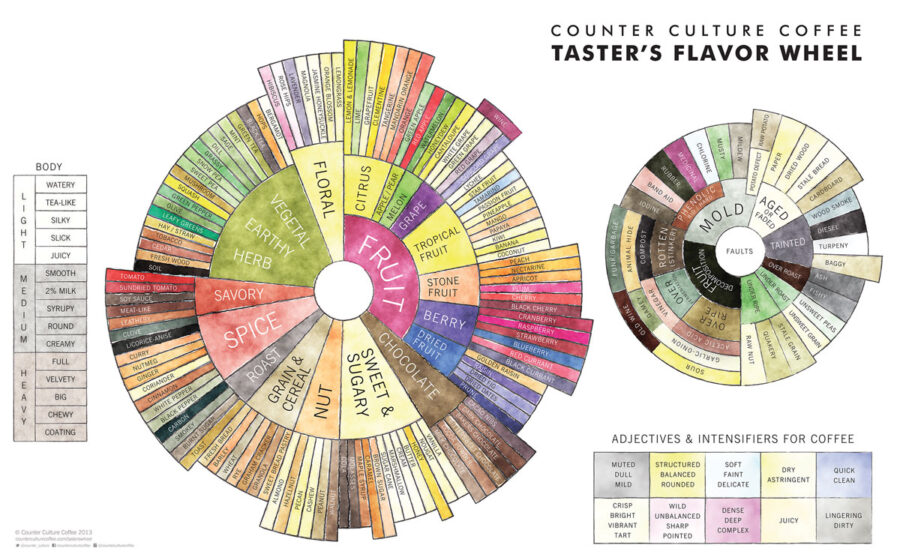[I]n the specialty-coffee world, the Flavor Wheel—a tool designed in the late-1990s by the SCAA—is ubiquitous. The circular creation offers a glossary of terms to describe the taste, scent and texture of coffee, and it can be found behind the counter at many third-wave cafés, as well as in countless roasting facilities and cupping rooms—not just domestically but in the world’s far-off coffee-growing regions.
Updating such a mainstay instrument is no easy task, but it’s one that Durham, N.C.-based Counter Culture Coffee Roasters has taken on with the December release of its Coffee Taster’s Flavor Wheel. The creation is the work of Timothy Hill, Counter Culture’s coffee buyer and quality manager, who says the goal was to create an easy-to-understand flavor guide. “I’ve been leading tastings at Counter Culture for almost a decade now, and it’s always really hard to try to explain the [SCAA] Flavor Wheel to new tasters because there are so many descriptors on there that don’t make sense to the average taster,” he says. “Ours is just meant to be more user-friendly and really intuitive.”
Hill acknowledges that the SCAA’s Flavor Wheel—created by former executive director Ted Lingle—took a more science-based approach. “There’s a lot of brainpower and what I would call very high-level thinking that went into that wheel,” he says. “I actually think the original wheel is genius—doing the color gradient by molecular weight idea. It’s just not that consumer-friendly.” In aiming to create a more accessible wheel, Hill drew on his years of experience discussing coffee. He says he also consulted with Counter Culture’s other coffee buyers, Kim Elena Ionescu and Hannah Popish, to include terms they regularly use to describe coffees, and called on other roasters whose use of language he respected to include their descriptors. The goal is a wheel that is useful to both cuppers and consumers—and one that furthers communication between all parties. “I hope that having a tool based on a more common language makes it easier to calibrate, so that we can better guide consumers,” Hill says.
So how does the Counter Culture wheel differ from the classic SCAA one? To start, there are more terms, more than doubling the available words and almost exclusively using specific foods for reference points. The Counter Culture wheel delves into specificity in certain places—take chocolate and nut, for example, flavors that Hill thinks coffee cuppers commonly identify but gloss over in favor of unique notes that don’t necessarily describe a coffee’s most prominent flavor. “Honestly, I taste chocolate and nut in 80 percent of coffee,” Hill says. “There’s a reason that those categories are really big and they’re subdivided in our wheel—it gives a little bit more freedom for roasters and consumers to find those flavors that should be identified in that coffee.”
The Counter Culture wheel also offers a few diagrams to further the conversation about taste. On the left is a body chart that describes the characteristics that contribute to light, medium or heavy body in a coffee. On the right are a wheel detailing coffee defects and a chart for coffee adjectives and intensifiers, with colors that correspond to terms in the two wheels.
And just as the SCAA Flavor Wheel can be found in cupping labs around the world, Counter Culture hopes the new wheel will also travel internationally. Hill says it’s being translated into several languages, with cultural modifications being made for each idiom. “For example, we’re having someone translate it into Amharic for Ethiopia, and some of those descriptors aren’t going to make sense,” he says. “So they will have to come up with words that are more associated with that area.”
Hill says the initial feedback from the industry has been overwhelmingly positive, with more than 5,000 downloads in the first few weeks of the wheel’s release. There’s a link on the download page for users to offer feedback on the wheel, and Hill will take comments into account as Counter Culture refines the wheel in future updates. “We want people to collaborate with us and help make it better,” he says. “It’s definitely a work in progress, and it’s something that we plan on modifying once a year or every other year.”
—Chris Ryan is a freelancer and Fresh Cup’s former editor.

















